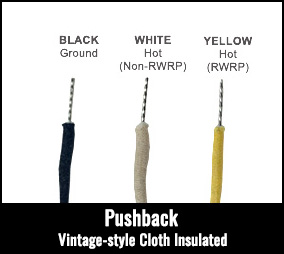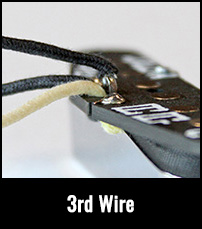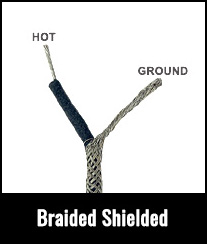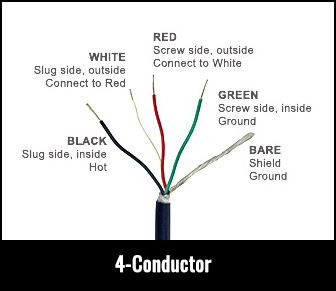By Mike Wohl
Pickup wire lead types can be confusing. Single-conductor, four-conductor, braided metal shielding, cloth pushback leads – what’s going on here? It can seem like an overwhelming number of variations. In this article we set out to help you make sense of the differences.
One thing to be aware of is that certain wire leads are only used with specific pickup types. Much of this is based on the historical precedent established by Gibson and Fender in the 1950s.
To start making sense of the options, it can be helpful to group pickups into those that are generally Fender-style, or Gibson-style.
Fender-style Lead Wires
Single-coil Fender-style pickups like Jazzmasters, Stratocasters, and Telecasters along with Jazz and Precision Bass pickups use simple leads that are relatively easy to understand. All of these models use two lead wires of different colors—one is hot and one is ground. At Lollar, we use white for the hot lead (or yellow to indicate that the pickup is RWRP relative to the others) and black for ground. The hot lead provides the signal’s entry path, and the ground carries it back out and provides a path for discharge of interference. Together, they complete a circuit.

In the case of Telecasters, both neck and bridge have metal parts: the neck pickup cover, and the bridge pickup’s baseplate. With a Tele neck pickup, the metal cover itself makes contact with the coil, providing a path to ground. The Tele bridge baseplate is also connected to the coil by a wire jumper and solder joint on the underside.
Strat and Jazzmaster pickups typically don’t have metal parts other than the slugs — though there are some exceptions depending on manufacturer. Because of this, there is no need for additional cover grounding. This applies to Jazz and Precision Bass pickups as well.
All these pickup types traditionally use separate hot and ground wires, each with a metal core insulated by waxed cloth – the cloth can be pushed back (rather than stripped) to expose the interior core, hence the name: pushback wire.

A variation we offer is the addition of a 3rd wire for Tele neck pickups, which provides an additional cover ground to the metal pickup cover. This is necessary for wiring pickups in series; in this case, what is usually the ground lead becomes a continuation of the hot lead, connected to the bridge pickup, which makes your strings and cover hot and quite noisy when touched. The 3rd wire provides an additional ground to the metal parts to eliminate this noise.
Gibson-style Lead Wires

Gibson-style pickups like humbuckers and P-90s work a little differently. We build them with one of two lead types: single-conductor or four-conductor leads.
The single-conductor name is misleading in a sense; the braided metal exterior shielding actually functions as a ground, whereas the interior is your hot lead. So, what looks like one wire is effectively two. These can be found on humbuckers or P-90s and are sometimes referred to as “vintage style” leads.
Four-conductor leads are found on some humbuckers and by nature only make sense with pickups that have two individual coils. In this case, the name is also sort of misleading: there are four leads and a ground (five total) all within a single insulated jacket. In the four-conductor lead, each of the humbucker’s two coils has its own lead where the coil starts, and one where the coil finishes. With our four-conductor leads, the black and white will be the start and finish of the North coil (slug side) and the green and red will be the South coil (screw side) start and finish respectively. The green lead functions as a ground for the two coils, and the bare wire functions as a ground for the pickup’s metal chassis. This additional ground gives you the ability to use series wiring, with the same principle applying as in the Tele neck pickup 3rd wire.

P-90s are single coil pickups, so a four-conductor lead is not an option. They typically use the vintage style single-conductor lead, with a braided metal exterior functioning as ground and the interior functioning as the hot. We can also produce a version with an additional lead in a jacketed 2-conductor version. This allows the Dogear P-90 version’s metal baseplate to be grounded, or to provide a path to ground if being wired in series.
Which version do I need?
Great question! Now that we understand what the options are, let’s talk about what you might need and why.
The vast majority of Strat/Tele/Jazzmaster/Jazz Bass and Precision Bass players will be just fine with the stock pushback leads. If you want to use a 4-way selector switch for series/parallel or in/out of phase switching, the addition of a 3rd wire to your neck pickup will allow you to take advantage of those functions. This will also apply to P-90s in terms of single conductor vs. jacketed two-conductor. It is not necessary to order a 3rd wire for both neck and bridge in most cases.
If your guitar has two humbuckers—each with its own volume and tone controls—and you want basic functionality, single-conductor lead wire is all you need. On the other hand, if you are doing coil splitting, in/out of phase, or series/parallel, then you’ll want to go with the four-conductor leads. It’s worth noting here that the four-conductor leads can be wired up to work like a single conductor, so there’s no disadvantage to ordering four-conductor if you think you might want to use those switching options later.
To use four-conductor leads like single conductor, simply twist and insulate the red and white leads, and solder the green to the bare wire. Your black lead will be hot, your red/white will be insulated, and your green/bare wire will function as your ground.
Which types of pickups can use four-conductor leads?
Another great question. Wiring a pickup with four-conductor leads requires a certain amount of room to access the coils in order to accommodate the larger lead. Not every pickup we make has enough room for this.
The Imperial, El Rayo, Raw Power, dB, and El Dorado as well as La Prima, Firebird, and Mini-Humbucker can all be ordered with four conductor leads as an option.
The Regal, LollarTron Traditional or Humbucker, Senn Model One, Johnny Smith do not have the space necessary, and are not available with four conductor leads.



